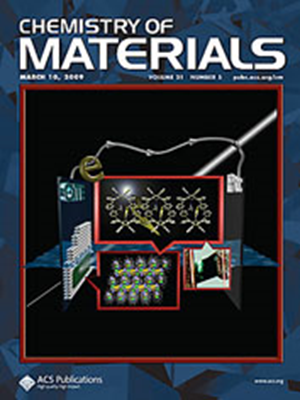Mussel-Inspired Catechol-Functionalized EVA Elastomers for Specialty Adhesives; Based on Triple Dynamic Network
IF 7.2
2区 材料科学
Q2 CHEMISTRY, PHYSICAL
引用次数: 0
Abstract
Marine mussels secrete adhesive proteins that enable them to bind to various surfaces (like rocks, ship’s hull, piers, etc.) in saline and wet environments. One of the main structural components in these adhesive proteins is the presence of a unique catechol-based amino acid, l-3,4-dihydroxyphenylalanine (DOPA), which is responsible for interfacial binding and the rapid solidification of the proteins. Mimicking this functionality in synthetic polymers yields high-strength adhesives that can be attached to both dry and wet surfaces. In this study, a commercially available epoxy-functionalized elastomer, poly(ethylene-co-vinyl acetate-co-glycidyl methacrylate) (EVA-GMA), was modified with dihydroxycaffeic acid (HCA) via transesterification reaction to prepare catechol-functionalized EVA elastomer which in combination with diboronic acid showed self-healing and recyclable characteristics. The catechol-functionalized elastomers can self-heal both dry and underwater, as the catechols can form hydrogen bonding and coordination complexes with metal ions in both dry and wet environments. The tensile study demonstrated a significant improvement in the mechanical strength due to hydrogen bonding and boronic eater cross-linking. Fourier transform infrared (FTIR) and X-ray photoelectron spectroscopy (XPS) analyses unequivocally confirm the successful formation of covalent boronic ester cross-links along with metal coordination. The stress relaxation behavior of the boronic ester cross-linked EVA-GMA elastomer was examined at various temperatures to assess its dynamic properties. Moreover, boronic ester cross-linked elastomers showed significant self-healing properties (with a healing efficiency of ∼86%) and were monitored by using optical microscopy and tensile analysis. By incorporating boronic ester-based dynamic covalent bonds, metal coordination, and H-bonding into polymer networks, we achieved strong adhesion and their dynamic nature for fast and reversible adhesion. Interestingly, this catechol-functionalized EVA-elastomer-based adhesive showed excellent bonding characteristics toward different surfaces, as analyzed via lap shear test in both dry and wet environments.

以贻贝为灵感的儿茶酚功能化EVA弹性体用于特种胶粘剂基于三重动态网络
海洋贻贝会分泌粘合蛋白,使其能够在盐碱和潮湿环境中与各种表面(如岩石、船体、码头等)结合。这些粘合蛋白的主要结构成分之一是含有一种独特的儿茶酚基氨基酸--l-3,4-二羟基苯丙氨酸(DOPA),这种氨基酸负责界面结合和蛋白的快速凝固。在合成聚合物中模拟这种功能可产生既能附着在干表面又能附着在湿表面的高强度粘合剂。在这项研究中,通过酯交换反应用二羟基咖啡酸(HCA)对市售的环氧官能化弹性体聚(乙烯-醋酸乙烯-甲基丙烯酸缩水甘油酯)(EVA-GMA)进行改性,制备出邻苯二酚官能化 EVA 弹性体,该弹性体与二硼酸结合后具有自愈合和可回收的特性。儿茶酚官能化弹性体在干燥和潮湿环境中都能与金属离子形成氢键和配位络合物,因此在干燥和水下都能实现自愈合。拉伸研究表明,由于氢键和硼酸酯交联,机械强度显著提高。傅立叶变换红外光谱(FTIR)和 X 射线光电子能谱(XPS)分析明确证实了共价硼酸酯交联与金属配位的成功形成。在不同温度下对硼酸酯交联 EVA-GMA 弹性体的应力松弛行为进行了检测,以评估其动态特性。此外,硼酸酯交联弹性体还显示出显著的自愈合特性(愈合效率高达 ∼ 86%),并通过光学显微镜和拉伸分析对其进行了监测。通过将基于硼酸酯的动态共价键、金属配位和 H 键结合到聚合物网络中,我们实现了强大的粘附力及其动态性质,从而实现了快速和可逆的粘附。有趣的是,这种儿茶酚官能化的 EVA 弹性体基粘合剂在干燥和潮湿环境下通过搭接剪切试验分析,对不同表面都表现出了优异的粘合特性。
本文章由计算机程序翻译,如有差异,请以英文原文为准。
求助全文
约1分钟内获得全文
求助全文
来源期刊

Chemistry of Materials
工程技术-材料科学:综合
CiteScore
14.10
自引率
5.80%
发文量
929
审稿时长
1.5 months
期刊介绍:
The journal Chemistry of Materials focuses on publishing original research at the intersection of materials science and chemistry. The studies published in the journal involve chemistry as a prominent component and explore topics such as the design, synthesis, characterization, processing, understanding, and application of functional or potentially functional materials. The journal covers various areas of interest, including inorganic and organic solid-state chemistry, nanomaterials, biomaterials, thin films and polymers, and composite/hybrid materials. The journal particularly seeks papers that highlight the creation or development of innovative materials with novel optical, electrical, magnetic, catalytic, or mechanical properties. It is essential that manuscripts on these topics have a primary focus on the chemistry of materials and represent a significant advancement compared to prior research. Before external reviews are sought, submitted manuscripts undergo a review process by a minimum of two editors to ensure their appropriateness for the journal and the presence of sufficient evidence of a significant advance that will be of broad interest to the materials chemistry community.
 求助内容:
求助内容: 应助结果提醒方式:
应助结果提醒方式:


